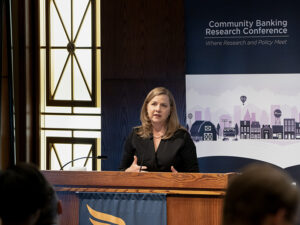
Regulators need to be more accommodating of de novos as the decrease in new banks poses risk to the stability of the financial system, Federal Reserve Gov. Michelle Bowman said April 14 during the Wharton Financial Regulation Conference in Philadelphia.
De novo formations have stagnated over the past decade as banks continue to face more pressure from credit unions and nonbank lenders. The number of FDIC-insured banks has fallen by nearly 50 percent over the last 21 years as more existing financial institutions have consolidated and merged. Though the pace of new bank formations has slightly increased in the past few years compared to immediately following the Great Recession, consolidations have still far outpaced new formations.
Bowman said the lack of new charters is highlighted by several current trends, including “charter strip” acquisitions, in which a buyer acquires an existing bank instead of applying for a new charter; the shifting of traditional banking services to less-regulated nonbanks; and the rising demand for banking-as-a-service partnerships. She noted that the number of new banks is further stifled by the higher capital requirements they face and limited business model options. By acquiring an existing bank, buyers can save money, build their own management teams and access existing core systems, she noted.
“Many banks have focused more of their activities and services on technology and innovation, with a corresponding increase in risk, including cybersecurity and operational risk,” she noted. “These trends will likely have significant consequences. Some of these are predictable, like limiting the availability of banking services to underserved communities. Others are indirect, like encouraging acquisitions through charter strip applications and pushing activities outside of the federal and state bank supervisory and regulatory perimeter.”
Bowman said charter strip acquisitions can have an adverse impact on local banking, as the target institutions are usually the banks that provide services to rural communities. “Even when these legacy bank businesses continue to operate as an add-on to the new charter-strip business model, the institution as a whole tends to become riskier, jeopardizing the long-term viability of the legacy banking business and its ability to continue providing services to the local community,” she added.
To Bowman, the bank formation process is time-consuming; regulators often require multiple applications to different agencies. The elongated process can complicate the chances of attracting strong board members, management and employees. Investors are sometimes reluctant to commit capital to a de novo using only forward-looking projections, she added.
“Consider whether requiring an up-front capitalization of a de novo institution in an amount far in excess of standard capital requirements is necessary, or whether in some cases a phased approach that takes into account the early performance of the de novo bank may provide similar risk protection with a lower capital burden,” she said.
Bowman said a model for U.S. regulators could be the United Kingdom’s Prudential Regulation Authority and the Financial Conduct Authority. The agencies’ New Bank Start-Up Unit provides potential applicants with resources covering the entire timeline of de novo formation, rather than only explaining the application filing process or requirements for early-stage operation.
“The process of creating a de novo bank starts before an application is filed, and is a multiyear process, ideally ending after a brief period of early operations with the de novo transitioning into a mature, viable banking franchise,” she said.
